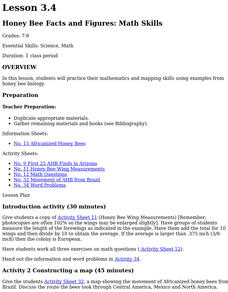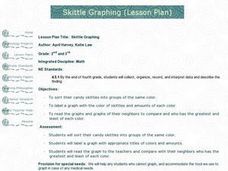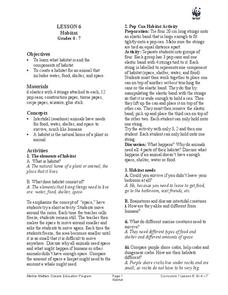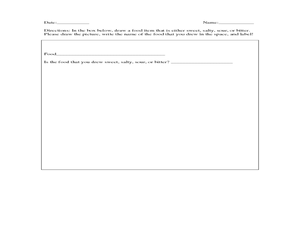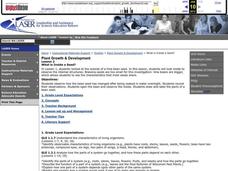Curated OER
Diet: Find the Carbohydrates
Students discover and discuss the functions of carbohydrates. Once they have taken notes and completed worksheets, they perform experiments using iodine to test for starch. Lesson topics include how carbohydrates are processed by the...
Curated OER
Homogenous and Heterogeneous Mixtures
Fourth graders explain and describe what a mixture is, distinguish between the two types of mixtures (which are heterogeneous vs.homogenous) and are able to create and appropriately label mixtures.
Curated OER
Honey Bee Facts And Figures: Math Skills
Learners practice their mathematics and mapping skills using examples from honey bee biology. Discuss why the colonies were found in this pattern. They examine food and water in the area, and how many humans live in the area where...
Curated OER
Skittle Graphing (Lesson Plan)
Students discuss the uses of graphs. They use color candies to count and sort before designing graphs. They label the graph papers with appropriate titles and candy colors. They complete the graph bars, and discuss the results with a...
Curated OER
Ocean Currents
Students label the names, relative temperature, distribution, and direction of flow of major ocean currents on a world map. They also explore and model the natural forces that affect the movement of ocean currents through demonstrations...
Curated OER
The Science of Glaciers
Students identify the contents of a glacier like those found in Patagonia. They construct a mini glacier model in class. Students compare and contrast the classroom model with Patagonian glaciers. They label specific parts of the...
Curated OER
Energy in Living Systems
High schoolers are asked: Is our life's purpose over when it's over? What happens to our bodies? They analyze the flow of energy through living systems. Students compare the metabolism of autotrophs with that of heterotrophs. They...
Curated OER
Your Digestive System
In this digestive system worksheet, 9th graders describe the function of each organ listed that aid in the digestion of food. Then they label each organ on the diagram given at the bottom of the sheet.
Curated OER
Plant Systems
In this plant systems worksheet, students write true or false for the 10 sentences about plant systems. Students then label the parts of the plant.
Curated OER
Thanksgiving Activity: Thanksgiving and Family
Students examine common Thanksgiving foods employing counting, singing, and discussion. Students sing "We Eat Turkey" and discuss what their families eat. Students will then be asked to create and plate of Thanksgiving food and count and...
Curated OER
Calorie Countdown
Students identify the advantages of a healthy diet and exercise plan. In this health activity, students bring in labels of different food products and calculate the amount of calories each serving is. Students keep a food diary to keep...
Curated OER
Habitat
Students explore the attributes of animal habitats. In this habitat lesson, students examine animal habitats as they conduct a scientific investigation to create an animal habitat that provides food, shelter, and space.
Curated OER
What's the Difference Between Concentration and Solubility?
High schoolers discuss the difference between concentration and solubility as well as examine the difference in a hands-on activity. Using water and table salt, they experiment with solubility. They create different concentrations using...
Curated OER
Foiling Spoilage
In this agricultural education worksheet, students read 6 descriptions of bacteria that cause food spoilage. Students then read 4 descriptions of preservatives that can be used to prevent spoilage. The worksheet is meant as a display.
Curated OER
Terrific Taste Buds
Learners explore descriptive writing by eating food in class. In this descriptive word lesson, students assess different foods in class such as jelly beans and utilize their vocabulary to describe the taste. Learners read the story...
Curated OER
Mixtures are Exciting
Fifth graders collaborate with other classmates to classify and create mixtures made of two or more substances. In this mixture lesson, 5th graders create solid-solid, liquid-solid, and liquid-liquid mixtures. Students discuss with the...
Curated OER
What is Inside a Seed?
Learners observe how the bean seed has changed after being soaked in water overnight and record their observations. They open the bean and observe the inside. Finally, students draw and label the parts of a bean seed and write the...
Curated OER
Create a Display
Students identify mollusks, create a display, research a particular species, and present their findings to the class. They collect and bring in a shell of choice from their local beach. Then, students label his or her shell with the...
Curated OER
The Respiratory System
In this respiratory system worksheet, students label the parts of the respiratory system shown in the given diagram. Then they write the name of the structure described on the line. Students also determine the difference between inhale...
Curated OER
Country Project
Students research any part of the United States that they want to know more about. This may include the culture, food or people. They have to present their information to the class, display a visual aid and write a paper on the...
Curated OER
What Makes up an Ecosystem?
Eighth graders design posters of working ecosystems using pictures from magazines. They label autotrophic, heterotropic, or saprotrophic energy sources, and identify predators and prey.
Curated OER
"The Tiger Who Came to Tea"
Young scholars complete various activities related to the book "The Tiger Who Came to Tea" by Judith Kerr Collins. They participate in a shared reading activity, list the foods from the story, write and read sentences in speech bubbles,...
Curated OER
All Wrapped Up
Students explore packaging. In this cross-curriculum lesson, students bring in samples of food packaging and identify the packaging as natural or manufactured.
Curated OER
Shells
Sixth graders label diagrams of the 6 different classes of mollusks and explain the meaning of the labeled terms. They identify 8 common New Haven shells. They organize their own shell collection during this series of lessons.




